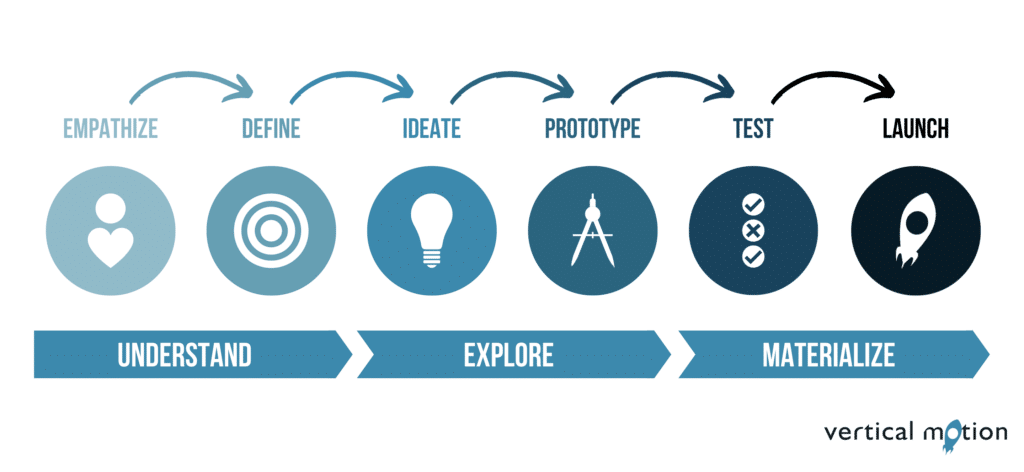Understanding Human-Centred Design and How to Apply It through the Design Thinking Process
What Is Human-Centred Design?
Human-Centred Design is a philosophy and problem-solving approach that places real people at the center of the product development process. This technique enables businesses and entrepreneurs to tailor their products and services to the needs of their target audience. The objective of human-centred design is to maintain users’ needs, wants, fears, and pain points as top of mind during each phase of the design thinking process. By doing so, businesses and entrepreneurs better equip themselves to build more intuitive, accessible, and reliable solutions that fully satisfy the needs of their customers.
Why Is Human-Centred Design Important?
To help explain the importance of human-centred design, we’ve developed the following thought experiment.
1. Consider a place you frequent regularly. It could be your local café, favourite vacation destination, or home.
2. Envision yourself in this place. Think about what you see, hear, taste, feel, and smell.
3. Following a few moments of reflection, fill in the following sentence:
“When I reflect on , the three things that I most associate with this place are , , and .”
E.g. “When I reflect on my local Starbucks café, the three things that I most associate with this place are welcoming baristas, fine-smelling Pike Place® Roast coffee, and delicious birthday cake pops.”
4. After finishing your sentence, consider a new place you’ve never visited or know very little about and fill in the sentence again.
E.g. “When I reflect on Mumbai, India, the three things that I most associate with this place are fine cuisine, Bollywood, and ancient history.”
As you can see in the example above, there is a noticeable difference between describing something you have experienced and something unfamiliar to you. Had someone who lives in Mumbai, or visits it frequently, written the second sentence, they may have described their love of the Elephanta Caves, Wankhede Stadium, or the Mabruk restaurant.
Similar is the case with design thinking. By failing to involve impacted individuals with first-hand experience of the problem, you begin developing a solution based on your own assumptions, beliefs, and limited experience. This leads businesses and entrepreneurs to invest significant amounts of time, money, and sweat equity into solutions that fail to fully address the needs, wants, and fears of their customers.
How Is Human-Centred Design Applied through the Design Thinking Process?

The Design Thinking Process. Photo: Vertical Motion Inc.
At Vertical Motion Inc., we have identified four human-centred design strategies for businesses and entrepreneurs to apply through the design thinking process. Although this is not an exhaustive list, the four strategies described below will equip you with the necessary tools to integrate the needs of your target market into your ideation process.
Map the System
Systems Mapping is the simplification of a complex structure through visual depiction that displays the relationships and feedback loops of central actors within an ecosystem. There are several ways of mapping systems including Cluster Maps, Connected Circle, Causal Loop Diagrams, and the Iceberg Model. Regardless of the technique, the goal of systems mapping is to come away with a better understanding of the impactful variables associated with the problem you seek to resolve. By doing this, you can better confirm that your proposed solution targets the primary customer problem rather than a symptom of something more.
For example, consider an individual with mild to moderate muscle pain. To alleviate discomfort, they may take over-the-counter (OTC) medication such as acetaminophen (Tylenol) or ibuprofen (Advil). However, this solution only treats the symptom of pain rather than the source. To treat the source of their pain, this individual may require appropriate medical treatment through physiotherapy, massage therapy, or acupuncture.
Acknowledge Your Biases
Each individual views the world through a different lens. This lens is formed and refined by daily experiences and interactions such as your childhood, education, community, media, friends, and so on. As a result, each person views life and the world around them differently from what their neighbour, friend, or colleague sees. Despite one’s best intentions to stifle this individual bias, it is rarely achievable when done alone and can often be overlooked in certain situations. As a result, this poses several risks for entrepreneurs and businesses engaging in product development and design thinking if left unchecked. Therefore, it is essential that you document your assumptions through the design thinking process. By doing so, you are better prepared to test and evaluate their validity through customer interviews and research.
Expand Your Lens
Another way to combat individual bias in product development is by implementing co-creation. Co-Creation is an approach to innovation that invites individuals within a complex ecosystem to play an active role in idea generation and problem resolution. By creating space for community collaboration, entrepreneurs and businesses are better able to verify their early assumptions and broaden their view of the problem. This leads to the development of more creative, impactful, and accessible solutions that address the needs, wants, and fears of customers.
It is important to note that co-creation is only effective once you have mapped the system in which you operate. Without systems mapping, it is unlikely that all essential stakeholders will be identified and invited to contribute to the design thinking process, thus prompting a restart. Therefore, it is important to follow these strategies in order to reduce the likelihood of pivoting and resource mismanagement.
Lead With Empathy
Empathetic Innovation is a vital component in achieving product-market success and cannot be overlooked in the design process. As Simon Sinek explains in his book Start With Why, “people don’t buy what you do; they buy why you do it. And what you do simply proves what you believe.” By leading with empathy, businesses and entrepreneurs ensure their focus remains on problem-solving and pain reduction, which is where society’s greatest innovations begin.
Final Thoughts
Human-centred design is an essential part of developing a product or service that strategically resolves the problem experienced by your customers. This concept, though straightforward, is something that develops through continuous implementation, testing, and refining. At Vertical Motion Inc. we offer a number of entrepreneur assistance programs that will guide you on how to apply these strategies and successfully launch your next great idea. Let’s connect and see how Vertical Motion can take you “From Idea to Execution and Beyond!”
Want to Stay Connected?
Vertical Motion Inc. is a trusted Canadian software development and entrepreneur assistance company that has supported the global efforts of startups, non-profits, B2B, and B2C businesses since 2006. With headquarters in Calgary and Kelowna, and team members coast to coast, Vertical Motion Inc. is recognized as an award-winning leader in the technology industry.
Our team of executive advisors, project managers, software developers, business analysts, marketing specialists, and graphic designers have extensive experience in several industries including — Energy, Finance, Blockchain, Real Estate, Health Care, Clean Technology, Clothing & Apparel, Sports & Recreation, Software as a Service (SaaS), and Augmented & Virtual Reality (AR/VR).
Come chat with us and let us take you “From Idea to Execution and Beyond!” 🚀

Written By Tyler Mikitka, communications officer on the bridge at Vertical Motion.


